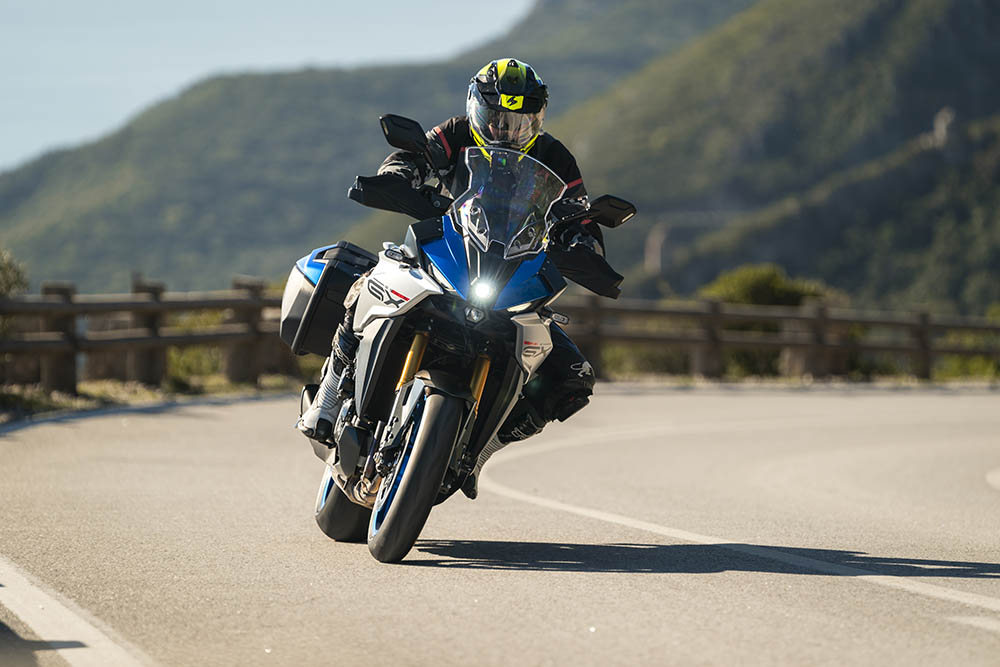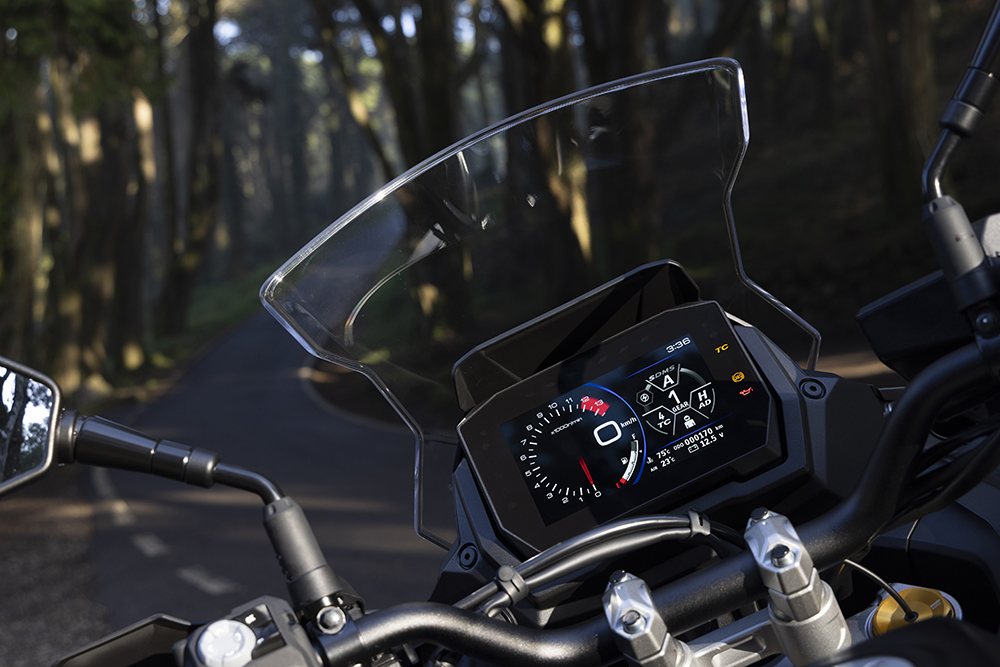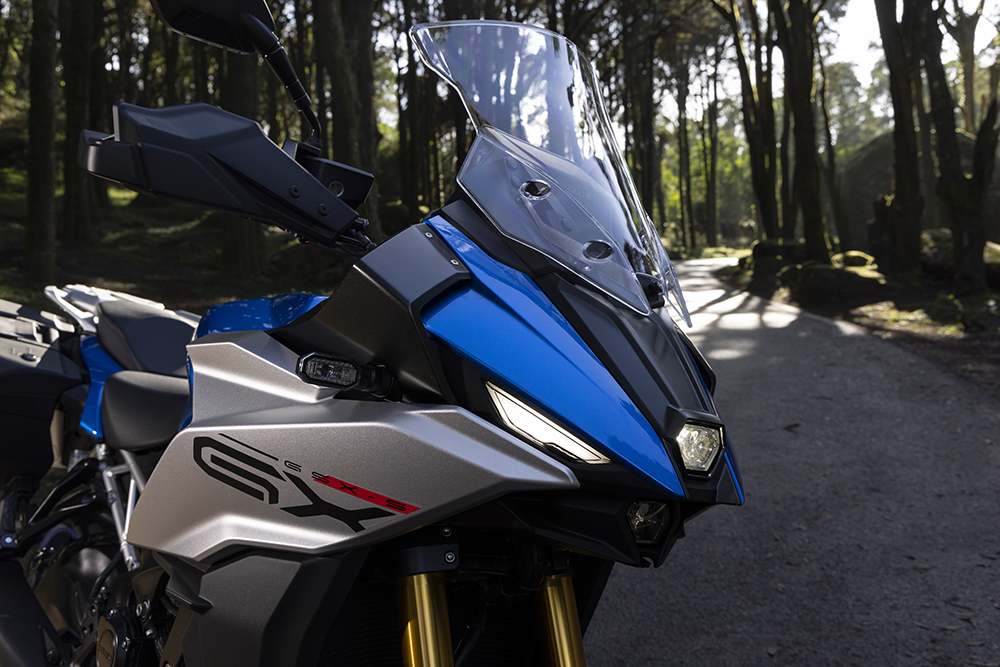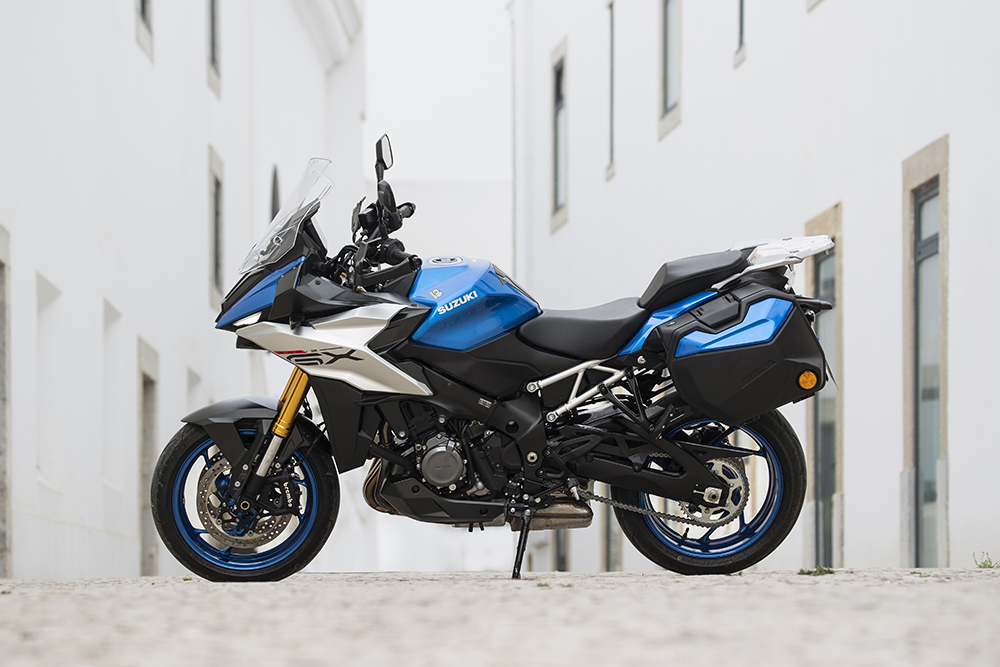This was going to be an interesting test. I was about to ride Suzuki’s new GSX-S1000 GX at its press launch in Portugal, and because it’s closely related to both the S and GT versions, both of which I have plenty of experience riding, I was keen to compare. The new GX is more closely matched to the sports touring style GT, and after really enjoying that machine for a couple of days in Scotland last year, I expected at least more of the same.
Sitting higher than the GT, thanks to its longer travel electronically controlled suspension, with a slightly more relaxed riding position (the 38mm taller bars now sit 43mm further back, with a 15mm higher seat) and a whole range of button-operated adjustment available from its advanced electronics suite, it was odds-on our two-day, 220-mile, test would bring some really enjoyable riding.
Getting aboard the taller GX is a little less straightforward for me, thanks to the restriction of my 30-inch inside leg. Not being able to plonk both feet flat on the floor meant I would always be conscious of the lie of the land whenever I came to a halt. However I would not describe this as a problem as such and, with a 15mm lower seat available as an accessory, there should be a solution for anyone who is bothered enough. Something else that didn’t really concern me, but which might possibly be an issue for longer-legged riders, is the height of the footrests. Suzuki aren’t offering a taller seat option and, although none of the taller testers complained during our shortish stints in the saddle, it is possibly something to consider.

With the rest of the ergonomics feeling good enough, I happily set off to be confronted by the challenge of getting through some early morning city commuter traffic. The GX coped happily, and though Suzuki had rather cheekily fitted some 36-litre panniers to the bikes (they’re an option, not standard fitment), filtering still proved easy enough thanks to their realistic overall width. It’s clearly never going to be as light, agile, and slim as a dedicated commuter bike or scooter, but few will be daunted when negotiating heavy congestion on the 1000.
The Suzuki’s commendable overall balance and well-mannered nature play a big part in this, and though its fully fuelled, ready to go weight of 232kg is hardly insignificant, it doesn’t take long to feel accustomed enough not to feel deterred. Steering manners are good and the brakes have plenty of power, even if they lack some initial bite. It’s perhaps the engine that’s most responsible for the GX feeling so at home in the busy urban zone. Sure, it pulls well and keenly right from the bottom of the rev range, but there’s a lovely softness and usability to the throttle response. As is the case with the majority of Suzukis these days, there are three power modes to choose from. Set in the B position for the early part of the ride, response is prompt but still friendly. It’s naturally more eager when the sharpest, A, mode is chosen (done in a jiffy, via the easy to access ‘bar-mounted buttons) but only the most nervous or ham-fisted riders would think it too abrupt. I won’t go into too much detail just yet, but each of the modes has a predetermined effect on the traction control and suspension damping settings too. As you’d expect, the slower the throttle response, the more intrusive the traction control becomes, with the suspension action also getting noticeably softer. More of that later…
Getting out of town came as a relief, though with higher speeds came some criticism. First off, the screen, though three-position adjustable through a range of 50mm, it can’t be altered without tools. I’d say a bike of this price (£14,499 otr) should at least have some easier means of adjustment. Plenty of other bike brands feature simple hand-adjustable arrangements, and though an electric height alteration would be best, just some sort of handle to instantly raise and lower the protective plastic really ought to be included. As it was, shelter was good enough for me not to trouble the Suzuki engineers to move it, or even fit a taller accessory option which was available to test. Screen height is a really personal issue I know, and I clearly can’t vouch for the preferences of others, particularly those of different dimensions. I did like the handguards though, and having them fitted to my own long-term test bike has often underlined their usefulness in poorer weather.

A more concerning issue came from the lack of feel and feedback from the OE Dunlop RoadSport 2 tyres. Not helped by the polished and slippery looking nature of a lot of the route we rode along, I rarely had the confidence to ride harder. They’re better when fully warmed, which was helped by the pleasant 20°C ambient temperatures we mainly rode in, but even so, tyres with better feeling would give a significant boost to confidence. I was still able to get a shift on but always careful to avoid generating more acute lean angles. The same rubber has felt better on the other S and GT models, so maybe the Portuguese road surface played as much of a part in the reducing my faith in exploring the performance of the GX much further.
As the day wore on, there was still a lot to enjoy on the Suzuki. The 150bhp, GSX-R1000 K5-derived engine might be 18 years old now, but it can still put on a good show with its broadly spread power and torque negating constant gearchanges, even if they are assisted well by the slickness of the ‘box and standard-fitment quickshifter/blipper. The engine’s absolute strength is obviously not quite the same as it was back in its heyday, largely down to ever-tightening emissions regs restricting its output. Even so, revving the 1000 harder readily brings the reward of more excitement and a lot more speed, accompanied by the classic GSX-R soundtrack. Yet regardless of its impressive performance, it never quite stimulates quite as much as some other more up to date motors, Yamaha’s MT-10 being a good example.

The inline four motor’s behaviour is very representative of the whole bike really. And though there are plenty of things to praise about the GX, I definitely think it has a typical Japanese, mass-produced feel to it. By that I mean a slight lack of character and personality. I’m sure plenty won’t be bothered by this at all and will appreciate the Suzuki’s easy to ride and very sorted nature, as well as the brand reputation for reliability and dealer support. But though the GX can undoubtedly perform strongly and securely thanks to its dependable chassis manners, I think if being inspired by your bike is an important factor, then the GX might fall short of appeal a little bit. It just can’t quite match some European rivals in that respect.
One significant area where the 1000 does score very highly though is its dynamic effectiveness as a sport tourer. Suzuki are presenting the new bike as a ‘The Supreme Sport Crossover’, but I’ll just stick to viewing the GX as a bike that can cover miles quickly and efficiently. If you want a bike to do that, then the new GSX-S is worth a look. It has all the key hallmarks, with lots of comfort (unless you have the leg length of a giraffe perhaps), a big enough tank to travel 150-180 miles between fills, and sufficient sporty performance to despatch the journey promptly, and effectively. Cruise control, an anti-wheelie feature, lean-sensitive traction and ABS systems, the 6.5” colour TFT dash and USB port all help to boost safely and civility.
Assisting the mile-eating cause well is the GX’s Showa electronic suspension arrangement - a first for Suzuki. At the risk of making this become a bedtime read, I’ll simply say it gives the facility to instantly alter the way the wheels ride the road courtesy of the tuneable damping, and the height at which the rear of the bike travels, via the adjustable rear ride height. You can very quickly and finely tailor the Suzuki to attain your comfort and control preferences at the touch of a button, giving you the choices of Hard, Medium, and Soft, with the chance to fine tune each of those by a further six minor increments, a custom setting to suit you even better, or just opting for the semi-active Auto setting, you can have the very best chance of having a suspension action to suit you in a swift convenient fashion.

Mind you, it has to be said, once I’d found the setting I liked best, I stuck with it, regardless of the nature of the road I was riding over. Even so, it was always good to know, if I ever fancied softening the ride, that plushness was just a moment away. Any chosen settings always remain in place even after you switch the ignition off.
Perhaps the most relevant advantage of the electronic arrangement is that even though I’d quickly been able to tailor the GX to behave just how I wanted it, if I’d had to discover that via the more customary multiple adjustments with tools, it would have involved pulling over several of times to achieve. And as we all know, that’s such a chore, once you’re in the ballpark you learn to accept finding suspension perfection is just too inconvenient. Just for the record, the GX’s fork preload can only be altered physically, not having any electronic adjustment.
I must admit some other hi-tech features of the bike were more difficult to assess as their action is so subtle it’s difficult to evaluate. One such feature, called the ‘Roll Torque Control’ system, governs in predetermined fashion the ‘level of optimal drive provided under acceleration’ based on the info received from the six-axis IMU as it constantly measures lean angle and wheel speed. Suzuki claims the arrangement provides smooth uninterrupted power delivery, unlike the typical more reactive traction control which can cause a more jerky and interruptive feeling. Not having felt any such minor breaks in power at any point when getting on the throttle, gives me the impression it works well.

Another clever electronic feature is called ‘Road Adaptive Stabilisation’. Designed as its name suggests, to improve stability, it works on the basis of when the suspension action detects whether a road is beginning to affect chassis composure it triggers the ‘Suzuki Floating Ride Control’ to alter the damping and help smooth out the ride. It also adjusts the throttle butterflies to smooth out the throttle response. I’m not sure if I ever felt it was working, but I can certainly testify to the GX riding in secure fashion throughout the whole test.
The Suzuki is available now in limited numbers, but will be much easier to get hold of in the new year. Given its high spec and strong performance its £14,499 asking price is about right. It’s a good grand less than Kawasaki’s Versys 1000, probably its main competitor, and I think if you owned the GX, using it to good effect touring around the UK or Europe, you’d probably bond with the bike, and the issue of it lacking a little character would likely be reduced. I’m really looking forward to riding one in the UK, though I’d like to have some better Dunlops fitted to appreciate it at its best.
2022 SUZUKI GSX-S1000GX
Price: £14,499
Engine
Type: liquid cooled, 16v, inline-four, DOHC
Displacement: 999cc
Bore x Stroke: 73.4 x 59mm
Compression: 12.2:1
Carburation: fuel-injection, 40mm throttle bodies
Gearbox: six-speed, chain
Power: 150bhp @ 11,000rpm (claimed)
Torque: 106Nm @ 9,250rpm (claimed)
Cycle Parts
Chassis: alloy twin spar
Suspension: (F) 43mm USD forks, electronically adjustable compression and rebound damping, manually adjustable preload (R) rising-rate monoshock, full electronic adjustment
Brakes: (F) twin 310mm discs, four-piston radial ABS calipers
(R) 240mm disc, single-piston ABS caliper
Wheels/Tyres: Cast Aluminium/Dunlop (F) 120/70 17 (R) 190/50 17
Rake/Trail: 25.5degrees/97mm
Wheelbase: 1,470mm
Capacity: 19 litres (4.2gal)
Seat height: 845mm
Kerb weight: 232kg (511lb)
Contact: www.suzuki.co.uk


